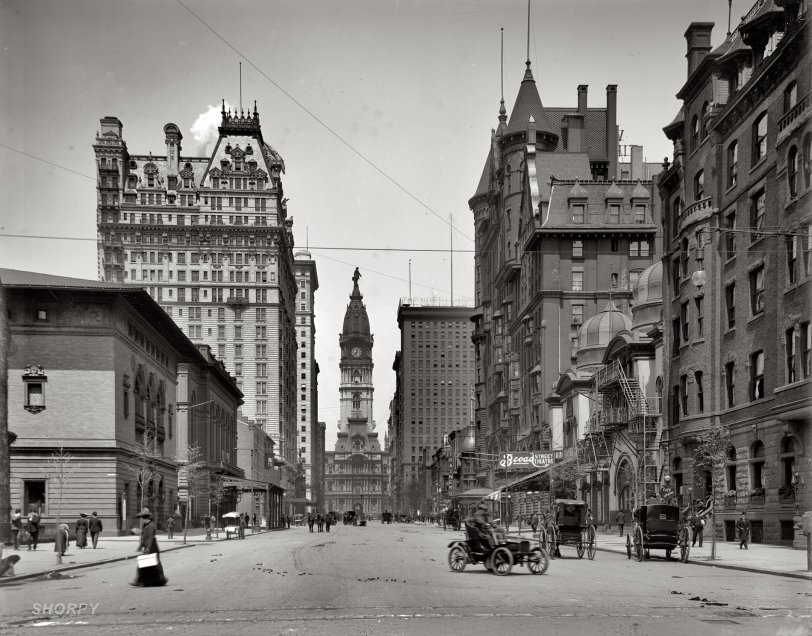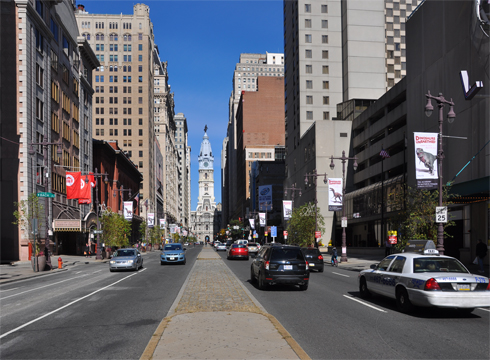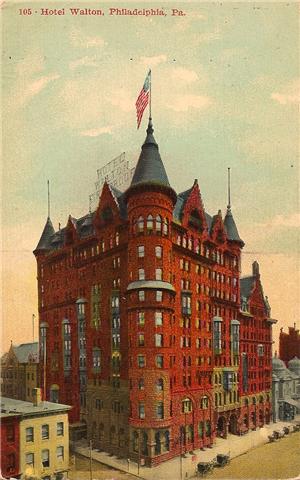


Framed or unframed, desk size to sofa size, printed by us in Arizona and Alabama since 2007. Explore now.
Shorpy is funded by you. Patreon contributors get an ad-free experience.
Learn more.

- Roll your own
- Rugged and real!
- A Charles Purcell - Mama Cass Connection
- Uncle SAAM
- Obfuscation
- One Chocolate Soldier rode away
- Victor Marquis de la Roche
- The Little House Across Way ...
- Vanderbilt Gates
- Vanderbilt Mansion
- You can still see that gate
- Withering heights for me
- So Jim,
- Top Heavy
- Re: Can't Place It.
- Bus ID
- Since you mention it
- The White Pages ?
- Moonlight Tower
- 1907?
- Fire(men) and Water
- Can't Place It
- Can anyone
- Wings
- Where's Claudette and Clark?
- Overbuilt Rolodex
- One song
- Give Me Wings Please!
- PRR
- Pinball Wizards
Printporium
Broad Street: 1905

Philadelphia circa 1905. "Broad Street north from Spruce." Detroit Publishing Company, 8x10 glass negative. Library of Congress. View full size.
Early auto
The car rushing through the photo is a 1904 Covert runabout.
+108
Below is the same view from October of 2013.

RE: Tall Building w/ Spires
The Hotel Walton. Photos of the lobby are also tremendous.

Missing Mansard Stories
Has anyone noticed that the top three or four stories of the building on the left at the corner of Spruce & Broad have been demolished. The building now extends only up to the grand cornice level. All of the articulations of the French-styled mansards, chimneys and other elements of the upper stories are gone. They probably created maintenance problems for the owner and were a source of leaks over time.
The building today looks far better in my opinion than it does in this photograph; the awkward and unbalanced details of its former crown are out of sync with the aesthetic of the lower block, which has the grand cornice for an appropriate and typical termination.
[The mansard-roofed building is gone. You're confusing it with the building behind it. - Dave]
Spruce and Broad
No this was taken from Spruce. (Check google maps)
I also went to UArts when it was Philadelphia College of Art. I lived on the corner of Broad and Spruce. Where the first building you see on the left is used to be the Schubert Theater now the Merriam Theater owned by UArts. The next building on the left would be the Academy of Music.
[The Broad Street Theatre, on the right, was at Spruce and Broad. Below: Street View from the same location. - Dave]
Inspired
What is the tall building on the right with the spires, it appears to have been torn down judging by the google map, what a shame. That was a beautiful building.
Philadelphia city planning
Philadelphia was laid out by its founder, William Penn. His plan from 1683 called for Broad and High (Market) Streets to be extra-wide. Penn didn't want narrow, crowded streets like ones in European cities at the time.
Wide streets
The wider the street the easier to turn a team of horses, mules, or oxen.
Better Buildings
For every Mies Van Der Rohe there's a thousand hacks thinking it's easy and that's why we have the canyons of today. Sad.
I'm amazed at the proportions of the aptly named Broad St. It looks like it could handle 10 or 12 carriages wide! Any idea why they went that wide and was that the norm? Certainly made it easy to convert into the car age.
Seven Lamps
"These building look far better than what replaced them."
They usually do. Modern architecture seems to be created by people who never progressed further than stacking blocks on top of each other. But that's just my opinion.
Used to be better
I went to UArts in Philly and the building on the right with the turrets was replaced by the Terra building (where I took some of my classes). This picture was definitely taken on Locust Street (I lived around the corner). These building look far better than what replaced them).
No Generica
This picture has such amazing details. I really love the different styles of the buildings. There are places in CA where you can get lost so easy because every house looks exactly the same. I can look at this picture for hours.
Academy of Music
The Academy of Music is the building on the left. The theater on the right was the Broad Street Theatre, torn down in 1937.
http://libwww.library.phila.gov/HIP/HIPSearchItem.cfm?ItemID=pdcl00176
The Theater
JimsShip, the theater is still standing. It's the Academy of Music, it opened in 1857.
Early Auto
I consider myself a "car buff" but these very early autos elude identification for me. Any guesses? Even if we don't know the make, the sight of a lone automobile on the dung-strewn streets is one of those great transitional moments.
Philly Soul?
Way to go, man! Great shot. I live right outside Philly. I love seeing old pics of places I know well. Shorpy is showing some love for the Two-One-Five, representin' old school style!
Keep up the fantastic work, my friend! I visit your page daily for stuff just like this.
Cheers!
Old photography
People often comment on the sharpness of these old large format photos, but they're superior in another way as well. See how the vertical lines in the modern picture all lean in toward the center because the camera is looking up, while the old view camera could be adjusted to eliminate this distortion and keep the vertical lines vertical.
[There are plenty of modern film and digital cameras that will accommodate shift lenses, which are widely used in architectural photography. - Dave]
Today's Broad
Rooftop signs
On the left of the picture is a rooftop sign that reads "THE NORTH...." and the building in front of it seems to have the same type of sign. Anyone know what they said?
Also I think the theatre on the right is still in use today. (Maybe Ron can verify.) I lived in Philly for six years and was always amazed at the buildings. It's so wild to see what it looked like back in the day. This is why I love this site.
[There is no rooftop sign on the building to the left but there is a flag -- it says Bellevue, for the Bellevue Stratford Hotel. The "North" sign is on the tower to the right, atop the North American Building. - Dave]
Horse droppings
were a major problem in big cities in the equine era. The streets had to be scooped up frequently, which required a large force of street cleaners.
According to this article, "at the turn of the nineteenth century, New York City's infrastructure relied upon disease-creating entities such as the horse. Between 100,000 and 200,000 horses lived in the city at any given time. Each one of those horses gave off 24 pounds of manure and several quarts of urine a day."
City Hall
Broad street leads to City Hall which is the tallest and largest masonry building in the world, using no steel. The walls of the first floor are over 20 feet thick to support the weight of the building. I have seen this building just about every day of my life and I still stop to look at its beauty.
Emissions
Back when you really had to worry about your carbon footprint.
Seven-O-Five or 12:35?
Trying to determine the time of day is not too easy for old eyes, but it seems like there are LOTS of parking spaces available. Also, imagine wearing a long dress and then trying to avoid all the horse poop in the street. People seemed very civilized 108 years ago. The architecture was quite elaborate as well. Nice photo.
[In answer to your question: Look at the shadows. - Dave]
























On Shorpy:
Today’s Top 5